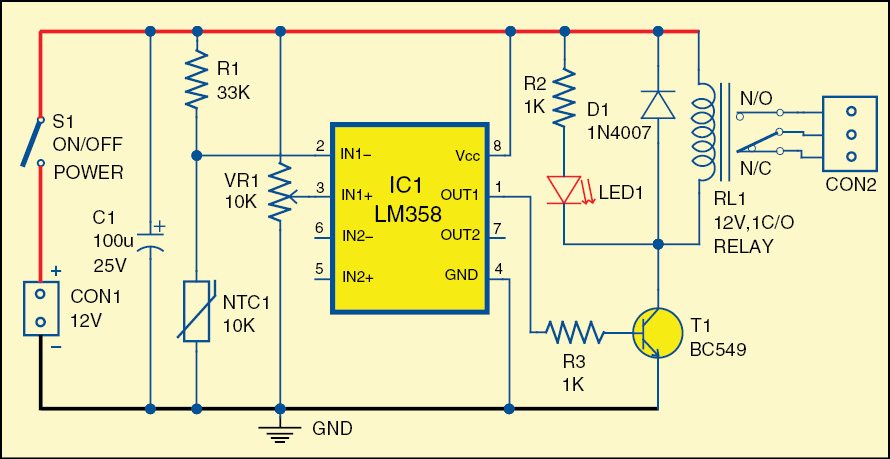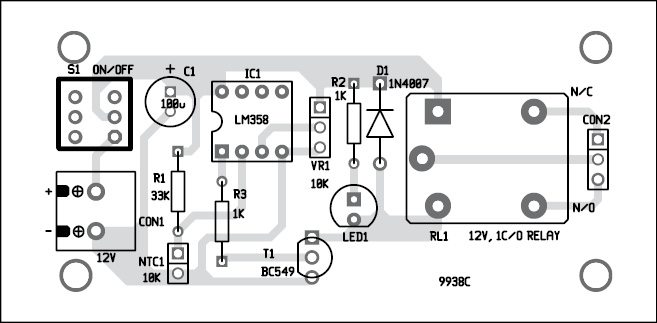NTC thermistors are often the preferred choice for temperature sensing and control in many applications, primarily because of their small package sizes and attractive price-performance ratios. An NTC thermistor’s sensitivity to temperature changes, even in small increments, enables the device to be used in temperature-sensing/control applications. This project for the over-heat detector uses a 10k NTC thermistor.
Circuit and working
The circuit diagram of the overheat detector is shown in Fig. 1. It is built around a negative temperature co-efficient (NTC1), popular dual opamp LM358 (IC1), 12V, 1C/O relay and a few other components.
 Fig. 1: Circuit of the over-heat detector
Fig. 1: Circuit of the over-heat detector The dual opamp LM358 has been used here for sensing temperature variations near the sensor. At room temperature, thermistor resistance is around 10k. When the temperature increases, thermistor’s resistance becomes low and output of IC1 at its pin 1 becomes high. As a result, the npn transistor conducts and activates the relay.
For testing the circuit, using potmeter VR1, set reference voltage, say, 2V, at pin 3 of IC1. At normal room temperature, voltage at pin 2 of IC1 remains around 2.4V.
On slightly heating NTC1, voltage at pin 2 of IC1 decreases. When this voltage goes below 2V, output of IC1 at pin 1 goes high and relay RL1 energizes to activate the load connected to it.
Construction and testing
A single-side PCB for the over-heat detector is shown in Fig. 2 and its component layout in Fig. 3. Enclose the PCB in a suitable small box in such a way that the thermistor can be placed near the heating area. Since the thermistor is used as a sensor, better fix it at a spot from where it can sense the temperature. Ensure proper wiring of the circuit to avoid any mistake.
 Fig. 2: PCB of the overheat detector
Fig. 2: PCB of the overheat detector  Fig. 3: Component layout of the PCB
Fig. 3: Component layout of the PCB Download PCB and component layout PDFs: click here
Panel-mount the input and output interface and the on/off switch, as required.
Pradeep G. is B.Sc. (Physics) and a regular contributor to international magazines. He is also a small-business owner making school/college projects in South India.
This project was first published on 1 July 2015 and was updated on 30 April 2020.
https://www.electronicsforu.com/electronics-projects/hardware-diy/over-heat-detector

Δεν υπάρχουν σχόλια:
Δημοσίευση σχολίου
Το blog TEO O ΜΑΣΤΟΡΑΣ ουδεμία ευθύνη εκ του νόμου φέρει σχετικά σε άρθρα που αναδημοσιεύονται από διάφορα ιστολόγια. Δημοσιεύονται όλα για την δική σας ενημέρωση.